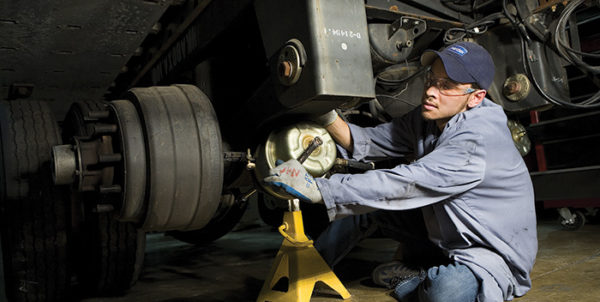When checking your air disc brakes, be sure to follow these tips provided by Haldex.
- Build the air system to governor cut-out (120-135 PSI), release the parking (spring) brakes and cycle the service brake pedal until the compressor cuts-in. Note: The cut-in pressure, minimum 85 PSI bus, 100 PSI truck/tractor (FMVSS 571.121).
- With the compressor cut-in (pumping) and the engine at idle, cycle the service brake pedal again until pressure is between 80 and 90 PSI, making a full service brake application and hold to maximum pressure for the duration of the application. The air compressor is required to maintain or build the system pressure . If system pressure does not maintain or build, repairs must be made to address leaks or failed components. For Federal Annual Inspection purposes; no audible air leakage is allowed. Release the foot pedal and establish full system pressure. Set the parking brakes and shut off engine.
- Determine the location of the air reservoirs: wet (supply), front service (secondary) and rear service (primary) reservoirs.
- With the engine off and the ignition switch on, drain the wet tank. The two service reservoir gauges or single gauge with two needles should remain unaffected (120-135 PSI) and the low air-warning device should activate at below 60 PSI; either a light or buzzer . If either or both gauges move at all, one or more one-way check valves are defective and require replacement.
- Drain the front service reservoir. The rear service reservoir gauge or needle should remain unaffected while the other gauge or needle will fall to zero. If both gauges or needles fall, one or more check valves are defective and require replacement. The low air-warning device should activate below 60 PSI.
- Ensure the parking (spring) brakes can be released . If the rear service reservoir gauge reads more than 100 PSI, drain to approximately 100 PSI. Be sure to make a full service brake application and hold at maximum pressure for the duration of the application.
- Check to ensure there is rear axle brake application. This is the Emergency Brake System .
- Measure each rear brake chamber pushrod stroke.
- Close all reservoir drain valves and run the engine to once again reach governor cut-out. Set the parking (spring) brakes and turn off engine.
- Drain the rear service reservoir. The front service reservoir gauge or needle should remain unaffected while the other gauge or needle will fall to zero. If both gauges or needles fall, one or more check valves are defective and require replacement. The low air-warning device should activate below 60 PSI.
- Ensure the parking (spring) brakes can be released. If the front service reservoir gauge reads more than 100 PSI, drain to approximately 100 PSI. Be sure to make a full service brake application and hold at maximum pressure for the duration of the application.
- Check to ensure there is front axle brake application. This is the Emergency Brake System . On a truck, bus or a truck/tractor, a modulated rear axle spring brake application should be noted (this indicates the Haldex Inversion Valve or Bendix SR-1 Valve is operating correctly). Note: Some vehicles do not require a modulated spring brake application, check with the vehicle or brake manufacture to determine this.
- Measure the pushrod stroke of each front brake chamber.
Tractor/trailer operational air disc brake checks
- Close all tractor reservoir drain valves, and run the engine to once again reach governor cut-out. Release both the tractor and trailer parking (spring) brakes and turn off engine.
- Drain the trailer air reservoir(s) to achieve approximately 100 PSI system pressure as indicated by the tractor air gauge(s). Be sure to make a full service brake application and hold at maximum pressure for the duration of the application (do not use the trailer hand control valve if equipped).
- Measure the pushrod stroke of each trailer brake chamber.
- Drain the trailer air reservoir(s) completely, and ensure that none of the trailer brakes apply. A clear ringing noise while tapping on each drum with a wrench indicates no shoe contact.
- Close the trailer reservoir drain valve(s) and run the engine to once again reach governor cutout. Ensure all parking (spring) brakes remain in the released position and turn off engine. At the rear of the tractor, uncouple the service and emergency gladhands. Note: The air will escape for a time from the tractor emergency gladhand, but should stop shortly. The tractor and trailer parking brake control valves should have automatically applied (automatic actuation is not required but usually does).
- Make a full service brake application (foot valve), making sure no air escapes from either of the tractor’s gladhands. If air does escape from either tractor gladhand, the tractor protection valve is defective and requires replacement. The tractor air system is required to have enough air at this time to make one controlled stop (there is no pressure requirement). Note: Other than a very brief burst of air from the “trailer” emergency gladhand, there should be no air venting from either trailer gladhand after uncoupling .
- Ensure that all brakes on all axles are in the applied (parked) position. A dead “clunk” sound while tapping each drum with a wrench indicates solid shoe to drum contact. The trailer’s parking (spring) brakes are considered to be emergency brakes and are required to hold for at least 15 minutes, axles without spring brakes must apply and hold using air.
- Reconnect the tractor to trailer gladhand connections. Run the engine to once again reach governor cutout and release all the parking brakes and turn off engine.
- Cycle the service brakes (foot valve) until the trailer brakes are seen to automatically apply. Note the air system pressure according to the dash gauges. The trailer emergency brakes are required to automatically apply when the tractor’s air system falls between 20-45 PSI.














